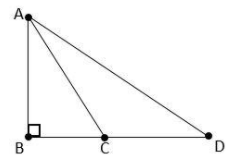
$ABC$ is a triangle right-angled at $B$. And $D$ is a point on $BC$ produced $(BD > BC),$ such that $BD = 2DC.$ Which one of the following is correct?
(A) $A{C^2} = A{D^2} - 3C{D^2}$
(B) $A{C^2} = A{D^2} - 2C{D^2}$
(C) $A{C^2} = A{D^2} - 4C{D^2}$
(D) $A{C^2} = A{D^2} - 5C{D^2}$
Answer
562.2k+ views
Hint: All the options are in square terms. And the given triangle is a right angled triangle. So the best way to check for the correct answer is to use Pythagoras theorem. Find the relation between different sides using Pythagoras theorem and then use the given information in the question to check which option is correct.
Complete Step by Step Solution:
It is given in the question that,
$\Delta ABC$ is a right angle-triangle at $B$.
And $D$ is a point on $BC$ produced such that,
$BD = 2DC$.
By the help of the question we draw a figure as,

Here it is given that $BD = 2DC$ . . . . . . (1)
According to figure
$BC + CD = BD$
Put in equation (1)
Then,$BC + CD = 2DC$
$ \Rightarrow BC = 2CD - CD$
$ \Rightarrow BC = DC$
Now, in $\Delta ABC$
Hypotenuse$(H) = AC$
Base$(B) = BC$
Perpendicular$(P) = AB$
Therefore, by Pythagoras theorem. We can write,
${H^2} = {P^2} + {B^2}$
$ \Rightarrow A{C^2} = B{C^2} + A{B^2}$ . . . . . . (2)
Again, in $\Delta ABD$
Hypotenuse$(H) = AD$
Base$(B) = BD$
Perpendicular$(P) = AB$
Therefore, by using Pythagoras theorem. We can write,
${H^2} = {P^2} + {B^2}$
$ \Rightarrow A{D^2} = A{B^2} + B{D^2}$ . . . . . . (3)
Subtracting equation (3) from equation (2), we can write
$A{C^2} - A{D^2} = B{C^2} + A{B^2} - A{B^2} - B{D^2}$
$ \Rightarrow A{C^2} - A{D^2} = B{C^2} - B{D^2}$ . . . . . (4)
We know that $BD = 2DC$ and $BC = DC$
By substituting these values in equation (4), we get
$A{C^2} - A{D^2} = D{C^2} - {\left( {2DC} \right)^2}$
$ = D{C^2} - 4D{C^2}$
$ \Rightarrow A{C^2} - A{D^2} = - 3D{C^2}$
$ \Rightarrow A{C^2} = A{D^2} - 3D{C^2}$
Therefore, from the above explanation the correct answer is (A) $A{C^2} = A{D^2} - 3C{D^2}$
Note:
In such a type of question. First look at the options, think about what is given. Then decide which approach would be best and then start solving. Because, such questions can have more than one way of solving, but other ways might be lengthy or complex than the one that we used. The approach we used is the easiest approach for this question. You only need to know the Pythagoras theorem.
Complete Step by Step Solution:
It is given in the question that,
$\Delta ABC$ is a right angle-triangle at $B$.
And $D$ is a point on $BC$ produced such that,
$BD = 2DC$.
By the help of the question we draw a figure as,

Here it is given that $BD = 2DC$ . . . . . . (1)
According to figure
$BC + CD = BD$
Put in equation (1)
Then,$BC + CD = 2DC$
$ \Rightarrow BC = 2CD - CD$
$ \Rightarrow BC = DC$
Now, in $\Delta ABC$
Hypotenuse$(H) = AC$
Base$(B) = BC$
Perpendicular$(P) = AB$
Therefore, by Pythagoras theorem. We can write,
${H^2} = {P^2} + {B^2}$
$ \Rightarrow A{C^2} = B{C^2} + A{B^2}$ . . . . . . (2)
Again, in $\Delta ABD$
Hypotenuse$(H) = AD$
Base$(B) = BD$
Perpendicular$(P) = AB$
Therefore, by using Pythagoras theorem. We can write,
${H^2} = {P^2} + {B^2}$
$ \Rightarrow A{D^2} = A{B^2} + B{D^2}$ . . . . . . (3)
Subtracting equation (3) from equation (2), we can write
$A{C^2} - A{D^2} = B{C^2} + A{B^2} - A{B^2} - B{D^2}$
$ \Rightarrow A{C^2} - A{D^2} = B{C^2} - B{D^2}$ . . . . . (4)
We know that $BD = 2DC$ and $BC = DC$
By substituting these values in equation (4), we get
$A{C^2} - A{D^2} = D{C^2} - {\left( {2DC} \right)^2}$
$ = D{C^2} - 4D{C^2}$
$ \Rightarrow A{C^2} - A{D^2} = - 3D{C^2}$
$ \Rightarrow A{C^2} = A{D^2} - 3D{C^2}$
Therefore, from the above explanation the correct answer is (A) $A{C^2} = A{D^2} - 3C{D^2}$
Note:
In such a type of question. First look at the options, think about what is given. Then decide which approach would be best and then start solving. Because, such questions can have more than one way of solving, but other ways might be lengthy or complex than the one that we used. The approach we used is the easiest approach for this question. You only need to know the Pythagoras theorem.
Recently Updated Pages
Master Class 9 General Knowledge: Engaging Questions & Answers for Success

Master Class 9 English: Engaging Questions & Answers for Success

Master Class 9 Science: Engaging Questions & Answers for Success

Class 9 Question and Answer - Your Ultimate Solutions Guide

Master Class 12 Economics: Engaging Questions & Answers for Success

Master Class 12 Maths: Engaging Questions & Answers for Success

Trending doubts
Which places in India experience sunrise first and class 9 social science CBSE

Fill the blanks with the suitable prepositions 1 The class 9 english CBSE

Write the 6 fundamental rights of India and explain in detail

Difference Between Plant Cell and Animal Cell

What is pollution? How many types of pollution? Define it

What is the Full Form of ISI and RAW




